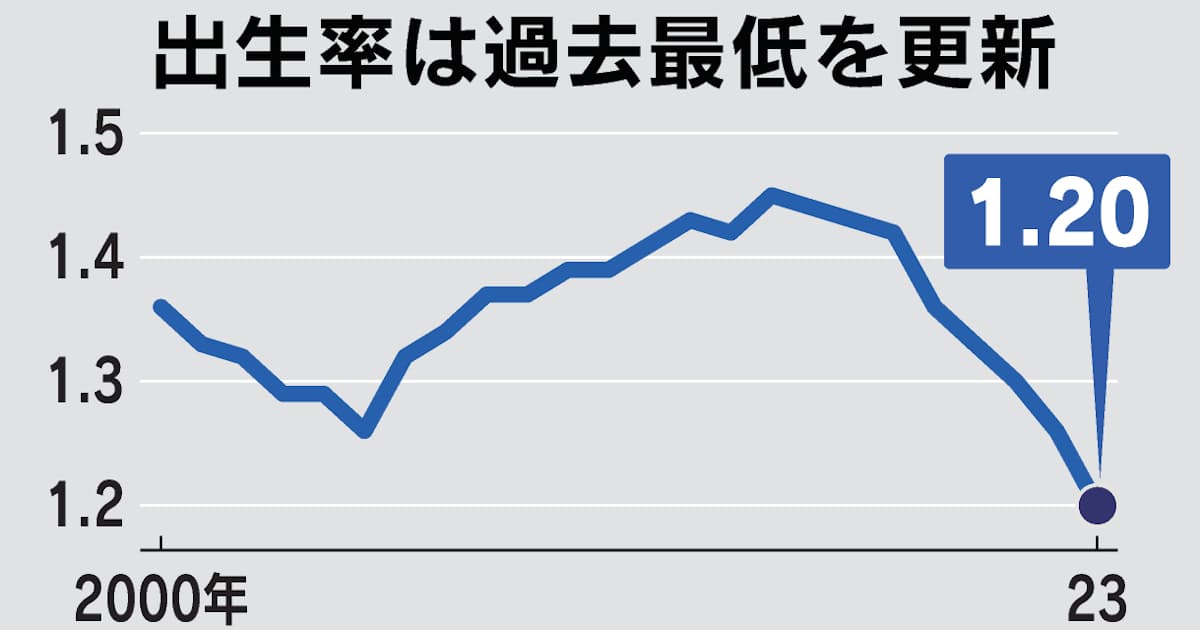2023年の出生率1.20、過去最低を更新 東京都は0.99 - 日本経済新聞

🌈 Abstract
The article discusses the record-low birth rate in Japan in 2023, with the total fertility rate dropping to 1.20, the lowest on record. It also examines the declining birth rates in other countries like Finland and South Korea, and explores the various factors contributing to the global trend of declining birth rates, such as economic burdens, changing values, and work-life balance challenges.
🙋 Q&A
[01] Japan's Declining Birth Rate
1. What are the key facts about Japan's declining birth rate in 2023?
- The total fertility rate in Japan reached a record low of 1.20 in 2023, down from the previous low of 1.26 in 2005 and 2022.
- The birth rate declined in all 47 prefectures, with Tokyo having the lowest rate at 0.99.
- The number of births declined by 5.6% compared to the previous year, while the number of deaths increased by 0.4%, leading to a natural population decline of 848,659.
- The decline in birth rate is attributed to factors like delayed marriage, fewer people wanting children, and economic burdens of raising children.
2. How does Japan's declining birth rate compare to other countries?
- Other countries like Finland and France are also experiencing declining birth rates, despite having extensive family support policies.
- South Korea's birth rate in 2023 was 0.72, the lowest in the world, due to factors like high education costs and work-life balance challenges.
- Singapore's birth rate also dropped below 1.0 for the first time in 2023, as living and education costs have risen.
- Taiwan's birth rate in 2023 was 0.87, as the country grapples with high housing prices and delayed marriages.
3. What are some policy approaches taken by other countries to address declining birth rates?
- Germany has focused on work-life balance reforms, leading to a increase in the time parents spend with their children.
- The U.S. has relied on immigration to drive economic growth, while Japan's approach to integrating foreigners lags behind.
- South Korea has invested heavily in child-related subsidies and benefits, but has yet to see a significant improvement in its birth rate.
[02] Factors Contributing to Declining Birth Rates
1. What are the key factors contributing to the declining birth rates globally?
- Changing values and priorities, with fewer people prioritizing having children
- Economic burdens of raising children, including high education and housing costs
- Work-life balance challenges, especially for women
- Delayed marriage and fewer people getting married
2. How do these factors differ across countries?
- In East Asian countries like South Korea and Taiwan, the high costs of education and housing are major barriers to having children.
- In Japan, the declining birth rate is also linked to the growing number of unmarried individuals and those who do not intend to have children.
- In Europe, factors like work-life balance and changing values play a larger role in the declining birth rates.
3. What are the potential limitations of policy approaches focused on financial support?
- While increased financial support for families can help, it may not be sufficient to significantly improve birth rates in the long run.
- Deeper societal changes, such as improving work-life balance and addressing the economic burdens of raising children, may be necessary to meaningfully address the declining birth rate trend.